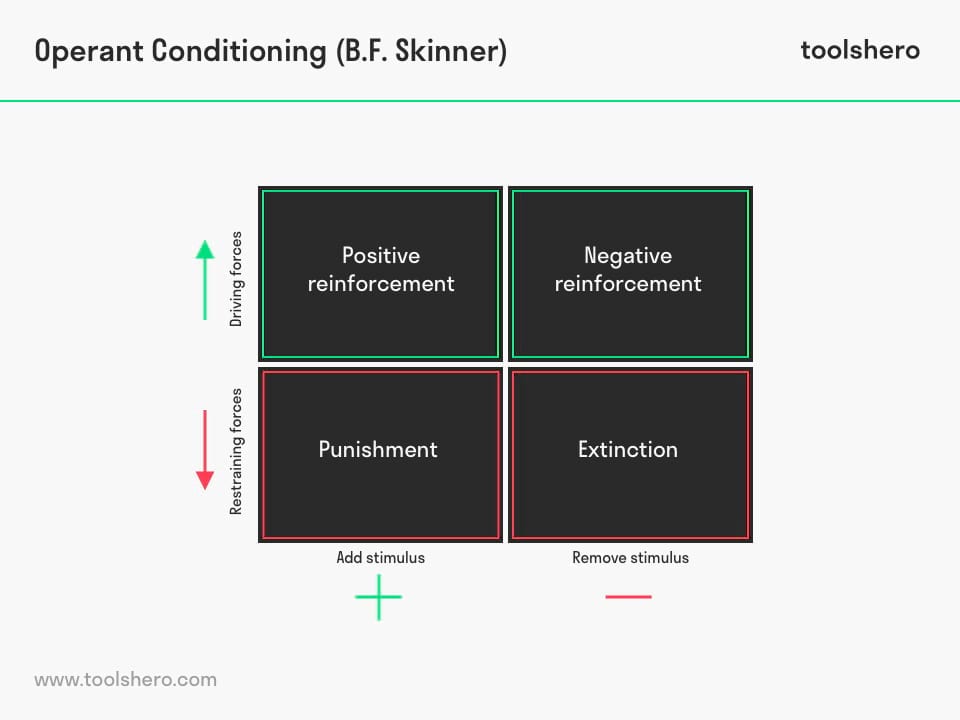Operant Conditioning (Skinner)

Operant Conditioning: this article provides a practical explanation of the Operant Conditioning by Burrhus F. Skinner. This article contains the explanantion of what is Operant Conditioning (definition and origin), an example, the difference with classical conditioning, and the main idea including various examples. After reading, you’ll understand the basics of this motivation theory. Enjoy reading!
What is Operant Conditioning? The basic theory and definition
Operant conditioning is part of the Reinforcement Theory of Motivation and focuses on good and bad behavior and the ways in which this behavior can be strengthened or reduced.
The Reinforcement Theory of Motivation, also referred to as behaviourism or learning theory, functions as a mechanism to influence human behaviour and behavior modification within a team or organisation by means of several methods from theory, such as reinforcement, negative punishment or eradication. There are four types of conditioning within the theory of operant conditioning:
- Positive reinforcement
- Negative reinforcement
- Punishment
- Extinction
The definition of Operant Conditioning (OC) is that is aimed at the motivation of employees and what encourages and reinforces good or bad behaviour at work and is part of the Reinforcement Theory of Motivation.
In the theory, positive and productive human behavior is rewarded, whereas negative human behavior is punished. The theory analyses the relationship between these two factors, the human behavior and the accompanying consequences. This is also referred to as operant conditioning.
The theory is fully focused on the target behavior of the individual when he or she takes action. It doesn’t oversee the inner state of the person, or the inner motivators and feelings. Nor is the theory aimed at the cause of certain behaviour in individuals, but it can be used as a tool to analyse control mechanisms and classical conditioning for specific behaviour.
According to the author of the theory, dr. Burrhus F. Skinner, the external operational environment must be positively and effectively designed to motivate employees.
Origin
The theory was developed by Burhus F. Skinner (1904-1990). This American psychologist Burhus F. Skinner was a professor at Harvard University, from which he retired in 1974.
Skinner based the theory on the ‘law of effect’. This means that people’s behaviour with positive consequences tends to be repeated (positive punishment), whereas behaviour with negative consequences doesn’t.
Example of Operant Conditioning
Operant conditioning is based on a simple premise: behaviors and actions that are followed by reinforcement will occur more often in the future. If everyone laughs out loud after telling a good story, chances are the same story will be told again later.
Another example of operant conditioning is often seen asking questions in a classroom or in the workplace. If a person raises his or her hand with a question and the teacher or colleague praises asking the question, the same person is more likely to ask his or her question in the future. This is called positive reinforcement and will be explained further in this article.
The opposite is also true: actions that lead to punishment will be weakened and less likely to occur in the future. When a student tries to tell a funny story, but no one laughs about it, there is little chance that the same story will be told again in the future.
If the student yells a random answer across the class without raising his or her hand, the teacher will lash out and the chances of this happening again are slim.
Classical conditioning versus operant conditioning
Classical conditioning and operant conditioning are two concepts that are closely related and both are central to behavioral psychology. Both forms of conditioning lead to learning, but the way in which this is done is different. In order to understand how both forms can be useful, it is important to understand the main differences between them.
Classical conditioning was first described by Russian physiologist Ivan Pavlov. The method mainly focuses on involuntary, automatic behavior and involves placing a neutral signal for a particular reflex.
Operant conditioning was first proposed by B.F. Skinner, an American psychologist. This method focuses on weakening or reinforcing voluntary behavior through the application of reinforcement or punishment after a specific behavior.
What is the main idea of operant conditioning?
This theory emphasises that the environmental factors of an individual determine behaviour.
For this reason, Skinner believed that the environment in which these employees are active, must be cleverly designed. According to this theory, a manager has four methods available to encourage desirable behavior and discourage negative behavior. This framework is also called the Skinner box.

Figure 1 – the behaviorism within Operant Conditioning
Positive Reinforcement in Operant Conditioning
According to OC, positive reinforcement is the positive number of responses that is given to an employee who displays good behavior.
This positive response increases the chance that the employee will display the good behaviour more often. Rewards are a form of motivation to repeat good behaviour, but aren’t essential.
However, if rewards are chosen, they could be financial bonuses, days off or other encouraging measures.
After the research of Frederick Herzberg, we know that rewards boost extrinsic motivation. Intrinsic motivation, however, proves to be more durable and more satisfying.
Example of operant conditioning (positive reinforcement)
This positive behavioral consequence is referred to as reinforcement. An example of a situation in which this takes place is a salesman who makes the sales quota after extra effort. His manager gives him a monetary reward for this, which can encourage this positive learn behavior in the future.
Negative Reinforcement in Operant Conditioning
According to this theory, negative reinforcement occurs when someone is rewarded by removing negative or undesired consequences of certain behavior to encourage positive behaviour.
Negative reinforcement is often confused with punishment, but those are certainly different. Negative reinforcement tries to reinforce positive behavior, whereas punishment is aimed at reducing the chance of bad behavior.
Example of operant conditioning (negative reinforcement)
An example. A project manager could ask his team members to send him a report on progress and completed deadlines every day. In general, this is considered to be an unpleasant task.
After several weeks of good behaviour, the manager might consider reducing the frequency of these reports to once a week. In doing so, the manager removes a negative behavioural consequence to encourage good behavior.
Punishment
Punishment refers to the imposing of negative behavioral consequences and must not be confused with negative reinforcement, which involves removing a negative behavioural consequence.
Punishment is aimed at reducing the chance of specific negative behaviors. It’s one of the most frequently used methods to control behavior, but many experts suggest that it shouldn’t only be used as positive and negative reinforcement, or as eradication.
Example of operant conditioning (punishment)
A warning is an example of punishment. A warning is a punishment that’s imposed upon an employee who arrives late at the office in the morning. This discourages this employee from being late again, undesired behavior.
Eradication
According to this theory, eradication refers to stopping learned behaviour, for instance by refraining from giving positive reinforcement to someone.
Eradication implies the absence of reinforcements in general, to increase the chance of reducing undesired behaviour. Often, this is done by ending behaviour employees have learned during a certain period.
Example of operant conditioning (extinction)
An example. It’s possible that managers make employees work overtime in a busy period as positive reinforcement with the goal to have employees come to the office more often and longer.
This works well for a while, but after some time, the employees’ focus starts to wane and the work slows down.
Subsequently, the manager stops approving overtime and discourages the employees from working this much.
Eradication is a method that must be handled with care, because employees who no longer experience positive reinforcement don’t feel appreciated.
Consequently, eradication can severely damage the team’s moral and decrease productivity. This has negative consequences, not personally, but rather on the effectiveness of the organisation as a whole.
Timing
This theory is about encouraging behavioral changes. To realise the right behavioural changes and keep general behaviour in check, reinforcement must be applied more than once. There are various ways and time schedules for offering reinforcement to employees.
If behaviour is reinforced every time it is displayed, this is referred to as constant reinforcement.
In general, constant reinforcement is the fastest way of conditioning new behavior, although this often isn’t realistic and feasible in practice. Therefore, periodic schedules are regularly used. Periodic reinforcement entails that not all behaviors are reinforced when displayed. There are multiple types of periodic schedules with various intervals: a fixed interval schedule, variable interval schedule and a variable ratio schedule.
Interval schedules
In a fixed interval schedule, reinforcement occurs between fixed periods, for instance with a salary that’s paid every two weeks. In a variable interval schedule, reinforcement is offered on varying times. Here, no schedule is followed.
When a manager pays his employee a compliment because he arrives at the office so early, that probably wasn’t planned.
In a variable ratio schedule, reinforcement is given after a few desired behaviours have been displayed. A good way of achieving this is by giving a bonus so all desired behaviours are displayed during work hours.
Now It’s Your Turn
What do you think? Do you recognise the explanation of Operant Conditioning? What do you believe are factors that influence the motivation and positive behaviour of employees? Do you feel that punishment is a good method to reduce the chance of negative behaviour?
Share your experience and knowledge in the comments box below.
More information
- Skinner, B. F. (1963). Operant behavior. American psychologist, 18(8), 503.
- Staats, A. W., & Eifert, G. H. (1990). The paradigmatic behaviorism theory of emotions: Basis for unification. Clinical Psychology Review, 10(5), 539-566.
- Iversen, I. H. (1992). Skinner’s early research: From reflexology to operant conditioning. American Psychologist, 47(11), 1318.
How to cite this article:
Janse, B. (2019). Operant Conditioning (Skinner). Retrieved [insert date] from Toolshero: https://www.toolshero.com/psychology/operant-conditioning/
Original publication date: 01/15/2019 | Last update: 08/13/2023
Add a link to this page on your website:
<a href=”https://www.toolshero.com/psychology/operant-conditioning/”> Toolshero: Operant Conditioning (Skinner)</a>












